Bagalkot district
Bagalkot district(/ˈbɑːɡələkoʊteɪ/), is an administrative district in the Indian state of Karnataka. The district headquarters is located in the town of Bagalkot. The district is located in northern Karnataka and borders Belgaum, Gadag, Koppal, Raichur and Bijapur. The new Bagalkot district was carved out of Bijapur in 1997 via Government of Karnataka directive Notification RD 42 LRD 87 Part III.[1] The bifurcated Bagalkot district consists of nine taluks — Badami, Bagalkot, Bilagi, Guledgudda, Rabkavi Banhatti, Hunagund, Ilkal, Jamakhandi and Mudhol.[2]
Bagalkot District | |
|---|---|
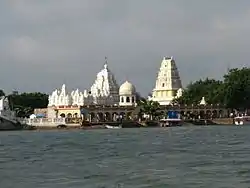 Kudalasangama in Bagalkot district, Karnataka | |
| Nickname(s): Kvati | |
 Location in Karnataka, India | |
| Coordinates: 16.12°N 75.45°E | |
| Country | |
| State | Karnataka |
| Founded | 1997 |
| Founded by | Government of Karnataka |
| Headquarters | Bagalkote |
| Talukas | Bagalkot, Rabakavi Banahatti, Guledgudda, Badami, Hunagunda, Jamkhandi, Mudhol, Ilkal. Bilagi. |
| Government | |
| • Type | Zilla Panchayat |
| • Deputy Commissioner & District Magistrate | R. Ramachandran IAS |
| Area | |
| • Total | 6,593 km2 (2,546 sq mi) |
| Elevation | 524 m (1,719 ft) |
| Population (2011) | |
| • Total | 1,889,752 |
| • Density | 290/km2 (740/sq mi) |
| Languages | |
| • Official | Kannada |
| Time zone | UTC+5:30 (IST) |
| PIN | 587101-587325 |
| Telephone code | + 91 (0)8354 |
| Vehicle registration |
|
| Website | bagalkot |
Historically, Badami, which is part of Bagalkot was the capital of the Chalukyan Empire of South India under Pulakeshin I, who conquered the district in 550 CE. Bagalkot's Badami taluk remained the seat of the throne of the Chalukyas from 550 CE to 753, when Chalukya king Kirtivarman II was overthrown by the Rashtrakutas.
Remnants of Chalukyan art and architecture are important tourist attractions in Bagalkot. Pattadakallu has many UNESCO World Heritage temples built by Vikramaditya II, while Aihole, which lies on the banks of the Malaprabha River, is an important temple town with over 140 temples belonging to both the early and later Chalukya times. The cave temples of Badami Cave Temples and the Jain temples of Rashtrakutas at Lokapura and Bilgi are also nearby.
Cottage industries occupy a predominant position in Bagalkot. The district is known for its silk and handloom industries.
The Ghataprabha River, Malaprabha River and Krishna River flow through the district. Koodalasangama lies at the point of confluence of the rivers Krishna and Malaprabha.
Like most districts in India, Bagalkot is headed by a Deputy Commissioner, with various Tahalsidars heading individual taluks in the district.
The Samadhi of 12th-century social reformist Basavanna, known for his crusade against caste exploitation, is located in Koodalasangama, a town in the taluk of Hungund.
Origin
Stone inscriptions identify Bagadige as the ancient name of Bagalkot. According to legend, the area was gifted by the mythological Rāvana, lord of Lanka, to his musicians. Other taluks in Bagalkot also have mythological origins. Badami, formerly known as Vatapi, was named after an asura king who, according to the Mahābhārata, ruled the area along with his brother Ilvala. Legend has it that both asuras were vanquished by the sage Agasthya. The northwestern taluk of Jamkhandi derives its name from the Chalukya temple dedicated to Jambukeshwara, a form of the Hindu deity Shiva. The town of Aihole, formerly the capital of the Chalukyan Empire of Banavasi was previously known as Ayyavole and Aryapura meaning Noble city. The western taluk of Mudhol was traditionally known as Muduvollal, literally Lovely town. The ancient town of Pattadakal was previously known as Raktapura, red town, and later as Pattadakal Kisuvoval.
The Greek astronomer Ptolemy previously identified many towns in the district of Bagalkot. Pattadakal was referred to as Petrigal, while Badami was known as Badiamaioi.[3]
In inscriptions, the old name of the town was given as Bagadage under the Chalukyas. Between 1664 and 1755 this territory was under the Savanur Nawab from whom it was annexed by the Peshwa, Balajirao. During 1778, Haider Ali took possession of Bagalkot. Later held by Savnur Nawab, it fell into the hands of Marathas in 1792. In 1800, the provincial manager, Anandarao Bhikaji, belonging to the Ratia family residing at Bagalkot, built a palace. In 1810, Peshwa Bajirao II gave the area to Nilakantharao Sarsubedar who held Bagalkot Fort supported by a garrison till Gen. Munro occupied it in 1818.
The place was a noted centre of the Indian independence movement and also of the unification movement. The place is on the banks of the Ghataprabha River. The place has a cement factory and is a centre of trade in cotton and groundnut.
Divisions
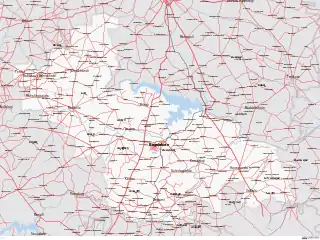
Bagalkot district is divided into ten taluks; each taluk is further subdivided into hoblies and villages and habitations. There are 21 hoblies in the district:
- Badami taluk: Badami, Kerur Kulageri
- Bagalkot taluk: Bagalkot, Kaladgi, Vidyagiri, Sitimani, Navanagar, Neelanagar
- Bilgi taluk: Anagwadi, Bilgi
- Hungund taluk: Amingad, Hungund, Karadi
- Jamkhandi taluk: Jamkhandi, Savalagi
- Terdal taluk: Terdal
- Rabkavi Banhatti taluk
- Ilkal taluk:Ilkal.Aminagada.Karadi
- Mudhol taluk: Lokapur, Mudhol, Mahalingpur
- Guledgudda taluk
History
Over 191 Middle Palaeolithic localities have been discovered in the Kalagdi basin of the district. The discovery of settlements in the village of Lakhamapura near the Malaprabha valley yielded the identification of quartzitic artefacts such as handaxes and cleavers.[4] A pre-Chalukyan brick temple was discovered at the foothills of Bachinagudda, in Pattadakal, where an idol depicting the bust of Chaturmukha Shiva was discovered. Evidence of megalithic habitation was also discovered at the foothills of Bachinagudda, as were Marahathi and Satavahana coins of a later period.[5]
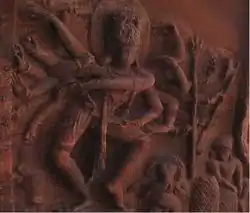
The first documented evidence of the existence of Bagalkot district dates back to the 2nd century CE, when the taluks of Badami, Indi and Kalkeri were mentioned in the works of the Greek astronomer Ptolemy. In the 6th century CE, the Hindu Chalukya rulers ruled over much of present South India. The Chalukyan king Pulakeshin I established Bagalkot as his administrative headquarters; the district retained its prominent status until the Chalukyan empire was sacked by the Rashtrakutas in 753 CE. The Chinese explorer Hieun-Tsang visited Badami and described the people as "tall, proud,...brave and exceedingly chivalrous".[6] He estimated the kingdom to be approximately 1,200 mi in circumference.
The period of rule of the Chalukyas of Badami, whose kingdom stretched from modern Karnataka to Maharashtra and Gujarat, was a highlight of Bagalkot's history. Chalukya king Pulakeshin II further consolidated the empire by battling with the Kadambas, Gangas, Mauryas of the Konkan, Gurjaras and Emperor Harshavardhana, whom he vanquished on the banks of the Narmada river[7] Accounts of war were inscribed on stone structures in the town of Aihole, now located in the taluk of Hungund. The Kalyani Chalukyas, descendants of the Badami Chalukyas, conquered the area before the dawn of the 10th century CE. Their rule was interspersed with wars against the Cholas and Hoysalas. The Kalyani Chalukyas moved their capital from Badami to Kalyani, in the present day district of Bidar. Akkadevi, sister of the Kalyani Chalukya Jayasimha II ruled in the area for more than 40 years from 1024 CE. During the course of her rule of the area, then known as Kisukadu, seventy villages from Bagalkot district were added to her administration. The Chola king Vīrarajendra seized the area by defeating Someshvara I at Koodalasangama. By the 11th century CE, all of Karnataka including Bagalkot fell into the dominion of the Hoysala Empire, first consolidated by Veera Ballala and later subordinated to the Sinda kings.
The Yadavas of Deogiri annexed Bagalkot in 1190 CE and ruled until approximately the thirteenth century. The Deccan invasion by the Muslim Khalji dynasty, led by Ala ud din Khalji in 1294 brought an end to the rule of the Yadavas. In the 14th century, much of this territory was overrun by Muhammad Taghlaq. That the Taghlaqs were undisputed overlords of this territory cannot be established since Harihara, first king of the Vijayanagara Empire, is supposed to have possessed territories as far north as Kaladgi in 1340 and because a fort was built under permission from Harihara in Badami during that period.[8] In the late 15th century, the Adil Shahi dynasty founded by Yusuf Adil Shah established an independent state with Bijapur as its capital. It is from this time that Bagalkot's history is homogeneous to that of Bijapur's. In 1818, after having lost their kingdom to the British, the Maratha Peshwas of Satara were crowned underlords of the kingdom. With the failing of their brief reign which ended in 1948, the district passed into the hands of the British Raj and was incorporated into the dominion of the Bombay Presidency.
India gained independence from the British in 1947; thereafter, the States Reorganisation Act of 1956 allowed for the creation of a Mysore State, renamed Karnataka in 1971, and for Bijapur (and therefore Bagalkot) to be included in its dominion.[9] A separate district of Bagalkot was carved out from the existing Bijapur district in 1997.
According to the 2011 census of the district, the towns of Bagalkot and Badami each had a population of over 100,000. Kannada is the primary language in the district. Approximately 88% of the district's population is Hindu, while 11% is Muslim.
Tourism
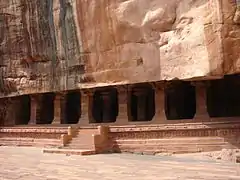
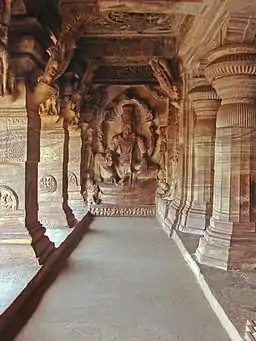
Badami taluk remained the seat of the throne of the Chalukyas from 550 CE - 753 CE, till Chalukya king Kirtivarman II was overthrown by the Rashtrakutas.
Pattadakal has many UNESCO World Heritage temples built by Vikramaditya II.
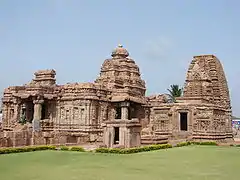
Mallikarjuna temple is in dravidian style while Kashi Vishwanatha temple is in nagara style at Pattadakal, built around 740 CE.
Aihole, which lies on the banks of the Malaprabha River, is an important temple town with over 140 temples belonging to both the early and later Chalukya times.
.JPG.webp)
Kudalasangama, where Basavanna's samadhi is located.
The 12th-century social reformist Basavanna, known for his crusade against caste exploitation, was born in Basavana Bagewadi.
The Mahakuteshwara temple dedicated to Shiva, is built in the Dravidian style.
Naganath Temple, located in a forest on the way to Mahakuta, is one of the early Chalukya temples dedicated to Shiva.
Mahakuta was once the epicenter of shaiva cult and is surrounded by hills.

Here, an annual fair and festival is held during January & February.
The temple in Banashankari is dedicated to Banashankari or Shakambari, a form of Parvati. It is located at Cholachagud, popularly called Banashankari.
Mudhol is the birthplace of poet Kavi Chakravarti Ranna.
Mudhol was one of the 9-gun princely states of British India.
Mudhol is famous for a breed of dog known as the Mudhol Hound.
Geography
The district of Bagalkot is situated entirely on the North Karnataka Plateau, which is part of the larger Deccan Plateau. Located in north-central Karnataka, Bagalkot is surrounded by Belgaum District to the west, Bijapur District and Gulbarga District to the north and north-east, Raichur District to the east and Koppal District, Gadag District and Dharwad District to the south-east, south and south-west respectively. It is positioned at 16°12′N 75°45′E and covers an area of 6593 km². Bagalkot district has nine taluks — Bagalkot, Ilkal.Badami, Hunagunda, Mudhol, Jamkhandi, Bilgi, RabakaviBanahatti,Teradal.Guledgudda].[2] The average elevation in this area reaches approximately 610 m. The climate is warm and dry throughout the year and rainfall is scarce. Bagalkot district receives the lowest rainfall annually in Karnataka. The average rainfall in the region is approximately 318 mm annually.[10] The months of September and December account for about 52% of the total annual rainfall.
Bagalkot is devoid of large canopy tree vegetation; the region is semi-arid. The Krishna River, Ghataprabha River and Malaprabha River flow through the region but are non perennial. Soil in the area can be categorised as either the majority black or minority red.[6] Black soil retains moisture and is often used for the cultivation of cotton. Rabi and jowar are primarily cultivated in Bagalkot, as are groundnut, cotton, maize, bajra, wheat, sugarcane and tobacco.[11] The district is also rich in mineral wealth. The village of Kaladgi, located 24 km from the town of Bagalkot, harbours copper. Iron ore also exists in the southern part of the district. Like much of Karnataka, the gneiss is the most common rock family. Common rock types in the region include greenstone, quartzite, sandstone and limestone. The dry climate makes the region susceptible to drought and crop failure. Bagalkot has not been affected by major seismic activity due to it being located in the stable Zone II.
Demographics
| Year | Pop. | ±% p.a. |
|---|---|---|
| 1901 | 466,200 | — |
| 1911 | 490,668 | +0.51% |
| 1921 | 467,062 | −0.49% |
| 1931 | 502,540 | +0.73% |
| 1941 | 570,522 | +1.28% |
| 1951 | 661,645 | +1.49% |
| 1961 | 771,602 | +1.55% |
| 1971 | 931,651 | +1.90% |
| 1981 | 1,151,005 | +2.14% |
| 1991 | 1,390,259 | +1.91% |
| 2001 | 1,651,892 | +1.74% |
| 2011 | 1,889,752 | +1.35% |
| source:[12] | ||
According to the 2011 census Bagalkot district has a population of 1,889,752,[13] roughly equal to the nation of Lesotho[14] or the US state of West Virginia.[15] This gives it a ranking of 249th in India (out of a total of 640).[13] The district has a population density of 288 inhabitants per square kilometre (750/sq mi) .[13] Its population growth rate over the decade 2001–2011 was 14.46%.[13] Bagalkot has a sex ratio of 984 females for every 1000 males,[13] and a literacy rate of 69.39%.[13]
Bagalkot is the second largest district in the Belgaum Division and the 15th most populous district in Karnataka. With over 1,651,892 inhabitants[2] (of which 28.97% were urban),[16] Bagalkot accounts for over 18% of the total population of the Belgaum Division. Bagalkot has 6 taluks, comprising a total of 18 hoblies and 627 villages. Of the 6 taluks, two are categorised as "More Backward Taluk" and one as "Most Backward Taluk". The district has 163 Gram Panchayats and 12 urban agglomerations. Bagalkot, with a decadal growth rate of about 19% is one of the ten fastest growing districts in Karnataka. Over 86% of the population in the district is Hindu, while 11% of the population is Muslim. Jains account for a little over 1% of the population, while Christians account for 0.17%. Scheduled Castes and Tribes constitute about 17% of the total population. Communal tensions are fairly uncommon in Bagalkot.
Kannada, the state language of Karnataka, is the most widely spoken language in the district. The literacy rate of the district is 57.3%, higher than national levels (52%) but lower than the mean literacy rate of the state (66.6%). Bagalkot ranks 22nd out of the 27 districts in Karnataka for adult literacy. The population density of Bagalkot is approximately 251 persons per square kilometer. Housing conditions in the district were identified as above average, per India's 2001 national census. About 96% of the houses surveyed were recorded as either "Good" or "Livable". Mass media (radio, transistor, television) penetration was about 67%.
Primary workers constitute about 43% of the district's population. Of these, 65% work in agriculture related activities. The sex ratio of the district is 980 per 1000 males, considerably higher than the national average — 927. The district's Net Domestic Income is US$ 5.8 billion. The per capita income of the district is about US$350 annually.
Education
Bagalkot has a number of educational institutions, including Basaveshwara Vidya Vardhaka Sangha and Sakri Sangha. A number of colleges are affiliated with Rani Channamma University, Belgaum, Visvesvaraya Technological University, Rajiv Gandhi University of Health Sciences, Ramanagara. Basaveshvara Engineering College (BEC) was established in 1963. S Nijalingappa Medical College, HSK (Hanagal Shree Kumareshwar) Hospital and Research Centre, Bagalkote is affiliated with Rajiv Gandhi University of Health Sciences.
The University of Horticultural Sciences (UHS) is headquartered in Navanagar, Bagalkote with its constituent colleges spread across the state.
Bagalkot houses the Krishi Vignan Kendra[17]
Economy
Agriculture is the largest employer in Bagalkot, with over 65% of the working population engaged in it; approximately 80% of female workers in Bagalkot are engaged in agriculture. Like most of north Karnataka, Bagalkot is very rich in black soil which is conducive to the cultivation of cotton. Bagalkot's economy was valued at US$5.6 billion, making it the 12th largest economy in Karnataka. The approximate per capital income is US$360. The chief crops cultivated are rabi and jowar, as well as groundnut, cotton, maize, bajra, wheat, sugarcane and tobacco. Jowar is largely cultivated because it can be grown during rainy seasons as well as during the winters. The crop also is the chief supply of food for the people. Pulses are also grown in the region, primarily tuvar daal, gram, kulith and mūng daal. Castor oil, linseed and sesamum are also grown in Bagalkot. Water supply for irrigation includes reservoirs such as the Kendur reservoir, which is six miles from Badami and the Muchkundi reservoir, which is 4 miles from Bagalkot. Famine due to lack of adequate rains is quite common in Bagalkot. A famine that struck the region in 1901 inflicted considerable financial loss to the agricultural industry in Bagalkot. The district has the fifth highest farmer suicide rate in Karnataka.[18] Efficient water management techniques and government sops have only marginally mitigated the repercussions of the drought stricken district.
A sizable proportion of the population also consists of weavers. The chief manufactures are cotton and silk cloths. Large quantities of cotton yarn are also dyed and exported to other parts of the state and country. Most of the immigrants in the district are either money lenders or cloth merchants.
In September 1901 a famine swept through the district, particularly affecting Indi, Sindgi and Badami taluks.
Industries
The focus sectors include agriculture, cement, sugar-based industries, silk and handloom industries.
It is one of the two handloom units (other is Dharwad) in India from where woven khadi is obtained and transported to Karnataka Khadi Gramodyoga Samyukta Sangha based in Hubli (which is the only licensed flag production and supply unit in India).
Many new industries are planning to begin in Bagalkot. New cement industries have been registered and are waiting for the permission to begin. There are other small-scale industries like Cement Pipe Industry which produce cement pipes, Bangle Industries which produce bangles, Match Stick Industries, Agarbatti Industries, Plastic Bag Industries etc. in Bagalkot. At the outskirts of Bagalkot city there are many small-scale industries set up. These come under the Vidyagiri area of Bagalkot city, which is the latest extension of the city. Small-scale industries like Ceramic Tile Industry, tyre industry, Stone Cutting And polishing Industry, milk Dairy etc. are running successfully. At Gaddanakeri there are many limestone industries and brick industries. The limestone industries produce lime for whitewash and painting. The brick industries produce bricks required for the construction of houses. There are local oil industries and oil refineries which produce oil from groundnuts, sunflower, sesamum orientale, cotton etc.
A brief overview of the industrial growth of Bagalkot is here[19]
Civic administration
| Bagalkote district officials | |
| Deputy Commissioner | Capt Rajendra IAS |
| Zilla Panchayat CEO | Smt Gangubai Manakar IAS |
| Member of Parliament (Bagalkot Lok Sabha constituency) | P. C. Gaddigoudar (BJP) |
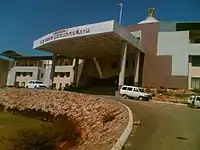
The Deputy Commissioner is the head of the administration of the district of Bagalkot. The Deputy Commissioners office provides municipal services to the district, collects census information, enforces judicial precedents, administers local elections and collects revenue. Tahalsidars assist the Deputy Commissioner in administrative matters at the taluk level — each taluk has one Tahalsidar. Rural areas of each taluk are administered by a locally elected Zilla Panchayat, headed by a Chief Executive Officer (CEO). The Zilla Panchayat is charged with rural development schemes related to irrigation, water supply, road and infrastructural facilities. Bagalkot district contributes one Member of Parliament (MP) to India's Lok Sabha. The district also contributes seven Members of Legislative Assembly (MLA)s to Karnataka's Vidhan Sabha, one from each taluk. Karnataka is one of only five states in the Indian union with an existing Vidhan Parishad (Legislative Council). Bagalkot district contributes four Members of Legislative Council (MLC)s to the Vidhan Parishad.
Bagalkot district's Zilla Panchayat body consists of 26 members. Of these, a president and vice president of the Zilla Panchayat are also elected. In addition, five standing committees consisting of Zilla Panchayat members numbering no more than seven are elected. The five standing committees include Planning and Finance, General standing, Agriculture and Industry, Education and Health and Social Justice.
Culture
The North Karnataka dialect of Kannada is primarily spoken in the district. Kannada itself is classified as a Dravidian language. The ethnologue identifies Bijapur Kannada as the closest dialect to the particular dialect of Bagalkot.[20] The traditional cuisine of the district is typical of the North Karnataka cuisine of the region. Jowar-based foods such as Bhakri are popular. Other forms of Indian bread made out of jowar are also common and are referred to as jolada rotti. As with most North Karnataka districts, Jhunka, a garbanzo bean-based dish, is usually eaten with Bhakri; the combination of these two dishes is referred to as Jhunka bhakar. Though not grown extensively in the district, rice, as in all of South India, is part of the staple diet and is imported from other parts of the state and region. Lentil and pulse-based broths are common. Ilkal town in Bagalkot district is known for the Ilkal sarees manufactured there.
The Chalukyan kingdoms of old have left an omnipotent presence in the district of Bagalkot. Several Hindu temples built by the Chalukyas exist in the town of Badami. Three cave-temple complexes constructed by the Chalukyan king Mangalesha (597–609 CE) exist within the district of Badami at the Badami Cave Temples. Of the cave-temples at this site, three are Brahmanical while one is Jain. The Badami fort, previously used by the Chalukyas as well as by Tipu Sultan also contains a prominent but now dilapidated Dravidian tower. Aihole, the former capital of the Chalukyan empire, is a destination for Chalukyan and pre-Chalukyan art and architecture. Pattadakal contains a group of ten major temples surrounded by minor shrines and plinths each depicting the architecture of the Chalukyas of Kalyani. The Government of India sanctioned a pilgrim centre in the town of Koodalasangama in honour of the social reformist Basavanna. Prasanna Venkata Dasa, widely regarded as the founder of Carnatic music and prominent member of the Bhakti Movement, lived in Bagalkot and composed his music in Kannada.
Cuisine
Amingad in Hunagunda Taluk is known for Amingad karadantu, a sweet dish. Galagali in Bilagi Taluk is known for Galagali Peda, a sweet dish. There are Khanavali's which are traditional vegetarian eateries usually serve Lingyat food.

References
- "A Handwork of Karnataka - Administration" (PDF). Government of Karnataka. pp. 354, 355. Archived from the original (PDF) on 8 October 2011. Retrieved 16 November 2010.
- "Bagalkot district statistics- Area and Population" (PDF). Archived from the original (PDF) on 17 July 2011. Retrieved 17 November 2010.
- "World Heritage Sites - Pattadakal". Archaeological Survey of India. Archived from the original on 30 October 2010. Retrieved 17 November 2010.
- Petraglia, Korisettar, et al. "An Extensive Middle Palaeolithic Quarry Landscape in the Kalagdi Basin, Southern India" Archived 22 July 2012 at the Wayback Machine. 2006. Antiquity. March 2003
- "Recent Discoveries". 2006. Archaeological Survey of India. Government of India.
- "Bijapur District"
- Arthikaje. "The Chalukyas of Badami". 2006. Ourkarnataka.com. Mangalore
- Sewell, Robert. "A Forgotten Empire: Vijayanagar; A Contribution to the History of India" Archived 2 December 2005 at the Wayback Machine. 2006. Blackmask.com. 2001
- "States Reorganisation Act, 1956. Part II, Article 306 7(b)". 2006. Indian Legislation. Government of India. 2005
- "Environmental Analysis Study". 2006. Department of Rural Development and Panchayat Raj. Government of Karnataka. July 2001
- "Karnataka: Situation Analysis and Literature Review" Archived 16 December 2004 at the Wayback Machine. 2006. Ford Foundation. October 2002
- Decadal Variation In Population Since 1901
- "District Census 2011". Census2011.co.in. 2011. Retrieved 30 September 2011.
- US Directorate of Intelligence. "Country Comparison:Population". Retrieved 1 October 2011.
Lesotho 1,924,886
- "2010 Resident Population Data". U. S. Census Bureau. Archived from the original on 19 October 2013. Retrieved 2011-09-30.
West Virginia 1,852,994
- "Archived copy". Archived from the original on 11 January 2010. Retrieved 2008-03-12.CS1 maint: archived copy as title (link)
- "Krishi Vigyan Kendra Bagalkot".
- "Burdened by debt". 2006. The Hindu. The Hindu Group. 14 Sep. 2003
- http://dcmsme.gov.in/dips/d.i.p-%20bagalkote.pdf
- Gordon, Raymond G., Jr. "Ethnologue report for language code:kan". 2006. Ethnologue: Languages of the World. SIL International. 2005
External links
| Wikimedia Commons has media related to Bagalkot district. |
| Wikivoyage has a travel guide for Bagalkot (district). |
